Numerical Simulation and Experimental Study on Detecting Effective Prestress of 1860-Grade Strands Based on the Drilling Method
Abstract
:1. Introduction
2. Microporous Release Theory and Derivation of Coefficients A and B
3. Numerical Simulation of Bare Strand Drilling
3.1. Establishment of Finite Element Models
3.2. Material Parameters
3.3. Finite Element Model Validation
3.4. Effect of Different Tensioning Stresses and Hole Margins on Stress Release from Boreholes
3.5. Effect of Drilled Hole Diameter on Stress Relief
3.6. Effect of Different Drilling Depths on Stress Release
4. Drill Hole Stress Relief Test
4.1. Overview of the Test
4.2. Bare Stranded Wire Outer Wire Drilling Test
4.3. Analyze Test Collection Data
5. Conclusions
- (1)
- The relationship between measured strain and axial tension can be determined using Kirsch’s analytical formula and microvia release theory. It was observed that there was a linear and positive correlation between the two variables, provided that certain conditions are met, such as strain gauge specification, drilling hole size, the specific depth of the hole, and a disregard for measurement errors. A relationship equation, incorporating coefficients A and B, may be established to represent the connection between strand tension and strain, within a given hole–edge distance.
- (2)
- When comparing the results of a simulated strand force condition produced using Midas FEA NX 2022 (v1.1) finite element analysis software with the theoretical calculation results reported by Feyrer, it was found that the maximum error for the central wire was 2.20%, while the maximum error for the side was 0.84%. These results demonstrate that the finite element model is capable of accurately simulating force distribution within the strand cross-section. Furthermore, it may be inferred that the model is capable of simulating the stress-release behavior of the strand-drilled hole.
- (3)
- The study involved the simulation of a strand drilling model under various conditions, including different hole spacings, tensile forces, drilling diameters, and drilling depths. The findings indicated a positive correlation between the value of tensile stress and the amount of stress released. Additionally, increasing the hole spacing reduced the effectiveness of stress release, with a trend similar to that observed for different tensile stresses. Moreover, as the diameter of the drilling hole increased, there was a gradual increase in the amount of strain released. Finally, it was observed that greater hole depths resulted in a more pronounced effect on strain release. The strain-release effect became increasingly evident as the drilling depth increased.
- (4)
- By conducting numerous simulations and feasibility analyses on a strand drilling model, it was determined that a drilling test program incorporating hole–edge distances ranging from 3 to 6 mm with diameters of 1.5 mm and 1.8 mm and a drilling depth of 2.5 mm could most effectively ensure measurement accuracy while minimizing adverse effects on the strand’s bearing capacity.
- (5)
- By conducting a comprehensive analysis of measured data for a drilling diameter of 1.5 mm, a drilling depth of 2.5 mm, and a hole–edge distance of 4 mm, and integrating this analysis with findings from finite element analysis, it was discovered that the effective prestressing strain and tension exhibited a linear correlation when the micro-hole release method was employed. Consequently, the measured strain value and tensile value were fitted using Origin software 2023b to establish a functional relationship. A linear correlation analysis was conducted to establish the relationship between the measured strain value and the tension value. The Origin program was employed to fit a function to the data, and the theoretical coefficients A and B were established using a functional equation.
- (6)
- Through the implementation of a thorough examination of the collected data regarding the dimensions of the drilling process (specifically, a diameter of 1.5 mm, a depth of 2.5 mm, and a hole–edge distance of 4 mm), and combining this with results derived from finite element analysis, a direct relationship was identified between the effective prestressing strain and tension when the micro-hole release technique was employed. As a result, the measured strain value and tensile value were subjected to fitting analysis using Origin software to determine a functional relationship. A linear correlation analysis was performed to determine the association between the measured strain value and the tension value. The Origin software was utilized to carry out a curve-fitting analysis of the data, and the theoretical coefficients A and B were determined by the application of a functional equation.
Author Contributions
Funding
Institutional Review Board Statement
Informed Consent Statement
Data Availability Statement
Conflicts of Interest
Nomenclature
| Strain per unit of distance in the axial direction at the edge of the hole (με) | |
| σ | Unidirectional stresses along the strand axial direction (Mpa) |
| FN | Value of effective tension applied to the stranded wire (kN) |
| AS | 1860-grade strand cross-sectional area (mm2) |
| E | Modulus of elasticity of steel strands (Gpa) |
| Closest and furthest distance from the center of the strain gauge sensitive grid (mm) |
References
- Yang, J.; Jung, J.; Kim, J. Applicability of 2360 Mpa grade prestressing steel strand: Performance of material, bond, and anchorage system. Constr. Build. Mater. 2021, 266, 120941. [Google Scholar] [CrossRef]
- Jacinto, L.; Pipa, M.; Neves, L.A.; Santos, L.O. Probabilistic models for mechanical properties of prestressing strands. Constr. Build. Mater. 2012, 36, 84–89. [Google Scholar] [CrossRef]
- Jiang, W.; Warby, K.M.; Henshall, L.J. Statically indeterminate contacts in axially loaded wire strand. Eur. J. Mech./A Solids 2007, 27, 69–78. [Google Scholar] [CrossRef]
- Shen, Y.; Ling, J.; Lu, X.; Zhang, Y.; Yan, Z. Steel wire prestress analysis of large section jacking prestressed concrete cylinder pipe (JPCCP): Site experiment and numerical investigation. Thin-Walled Struct. 2023, 184, 110420. [Google Scholar] [CrossRef]
- Chaki, S.; Bourse, G. Guided ultrasonic waves for non-destructive monitoring of the stress levels in prestressed steel strands. Ultrasonics 2009, 49, 162–171. [Google Scholar] [CrossRef] [PubMed]
- Li, X.; Zhang, B.; Yuan, C.; Tu, C.; Chen, D.; Chen, Z.; Li, Y. An electromagnetic oscillation method for stress measurement of steel strands. Measurement 2018, 125, 330–335. [Google Scholar] [CrossRef]
- Kralovanec, J.; Bahleda, F.; Moravcik, M. State of Prestressing Analysis of 62-Year-Old Bridge. Materials 2022, 15, 3583. [Google Scholar] [CrossRef] [PubMed]
- Maudi, M.S.; Shields, J.; O’connor, D.; Hutchens, E. Variation of prestress forces in a prestressed concrete bridge during the first 30 months. PCI J. 1996, 41, 66–72. [Google Scholar]
- Tinkloh, S.; Wu, T.; Tröster, T.; Niendorf, T. The Effect of Fiber Waviness on the Residual Stress State and Its Prediction by the Hole Drilling Method in Fiber Metal Laminates: A Global-Local Finite Element Analysis. Metals 2021, 11, 156. [Google Scholar] [CrossRef]
- Ma, W.; Bai, T.; Li, Y.; Zhang, H.; Zhu, W. Research on Improving the Accuracy of Welding Residual Stress of Deep-Sea Pipeline Steel by Blind Hole Method. J. Mar. Sci. Eng. 2022, 10, 791. [Google Scholar] [CrossRef]
- Zhang, Z.; Wu, J.; Zhang, C.; Xu, Q.; Chen, Y.; Wang, Z. Identification of Effective Prestress of Steel Based on Blind-hole Method. J. China Railw. Soc. 2023, 45, 166–175. [Google Scholar]
- Rendler, N.J.; Vigness, I. Hole-drilling strain gauge method of measuring residual stresses. Exp. Mech. 1966, 12, 577–586. [Google Scholar] [CrossRef]
- Chen, C.; Yuan, X.-f. Fine analysis of section stress of steel strand. J. Zhejiang Univ. 2017, 51, 841–846+878. [Google Scholar]
- Ghoreishi, S.R.; Messager, T.; Cartraud, P.; Davies, P. Validity and limitations of linear analytical models for steel wire strands under axial loading, using a 3D FE model. Int. J. Mech. Sci. 2007, 49, 1251–1261. [Google Scholar] [CrossRef]
- Wang, B. The Model Test Study on the Existing Stress Detection of Prestressed Hollow Slab Bridges Based on the Stress Releasing Method. Ph.D. Thesis, Chongqing Jiaotong University, Chongqing, China, 2009. [Google Scholar]
- Chen, J. Research on Effective Prestress Detection of Bridges Based on Blind Hole Method. Ph.D. Thesis, Harbin Institute of Technology, Harbin, China, 2016. [Google Scholar]
- Yuan, Q. Research on the Detection of the Effective Prestress of Prestressed Strands by Using the Blind-Hold Method. Ph.D. Thesis, Harbin Institute of Technology, Harbin, China, 2018. [Google Scholar]
- Nx, M.F. Version: FEA NX 2022 (v1.1). 2022. Available online: http://www.product.midasit.cn/index/ (accessed on 15 May 2022).
- Andreev, V.I.; Cybin, N.Y. The Inhomogeneous Plate with a Hole: Kirsch’s Problem. Procedia Eng. 2014, 91, 26–31. [Google Scholar] [CrossRef]
- Timoshenko, S.P.; Goodier, J. Theorya Uprugosti; Nauka: Moscow, Russia, 1979; 560p. [Google Scholar]
- Peng, Y.; Zhao, J.; Chen, L.-S.; Dong, J. Residual stress measurement combining blind-hole drilling and digital image correlation approach. J. Constr. Steel Res. 2021, 176, 106346. [Google Scholar] [CrossRef]
- Yan, S.Z.; Yu, X.J.; Wang, Y.M. A new method for calibration of release coefficient in residual stress measurement. J. Jilin Univ. Technol. 1995, 25, 49–54. [Google Scholar]
- GB/T5224-2014; General Administration of Quality Supervision, Inspection, and Quarantine of the People’s Republic of China. Steel Strand for Prestressed Concrete. China Standard Press: Beijing, China, 2014. (In Chinese)
- Jiang, W.; Yao, M.; Walton, J. A concise finite element model for simple straight wire rope strand. Int. J. Mech. Sci. 1999, 41, 143–161. [Google Scholar] [CrossRef]
- Judge, R.; Yang, Z.; Jones, S.; Beattie, G. Full 3D finite element modeling of spiral strand cables. Constr. Build. Mater. 2012, 35, 452–459. [Google Scholar] [CrossRef]
- Feyrer, K. Wire Ropes: Tension, Endurance, Reliability; Springer: Berlin, Germany, 2015; pp. 60–67. [Google Scholar]
- Jiang, J.; Deng, N.; Guo, X. Finite element simulation of cross-sectional stress of 1860-grade steel strand. Chin. Sci. Technol. Pap. 2021, 16, 193–198+204. [Google Scholar]
- Abdullah, A.B.M.; Rice, J.A.; Hamilton, H.R.; Consolazio, G.R. Experimental and Numerical Evaluation of Unbonded Posttensioning Tendons Subjected to Wire Breaks. J. Bridge Eng. 2016, 21, 04016066. [Google Scholar] [CrossRef]
- Qian, H.; Zong, Z.; Xie, G.; Liao, J.; Du, M. Refined simulation of elastic-plastic static behavior of grade 1860 strand wires. J. Southeast Univ. 2019, 49, 624–630. [Google Scholar]
- Mouhib, N.; Wahid, A.; Sabah, F.; Chakir, H.; Elghorba, M. Experimental characterization and damage reliability analysis of central core strand extracted from steel wire rope. Eng. Fail. Anal. 2020, 120, 105103. [Google Scholar] [CrossRef]
- Minaei, A.; Daneshjoo, F.; Goicolea, J.M. Experimental and numerical study on cable breakage equivalent force in cable-stayed structures consisting of low-relaxation seven-wire steel strands. Structures 2020, 27, 595–606. [Google Scholar] [CrossRef]
- Ma, X.M.; Ou, Q.Y. Numerical simulation for hole-drilling strain gage method applied on curved surface. J. South China Univ. Technol. 2019, 47, 25–31. [Google Scholar]
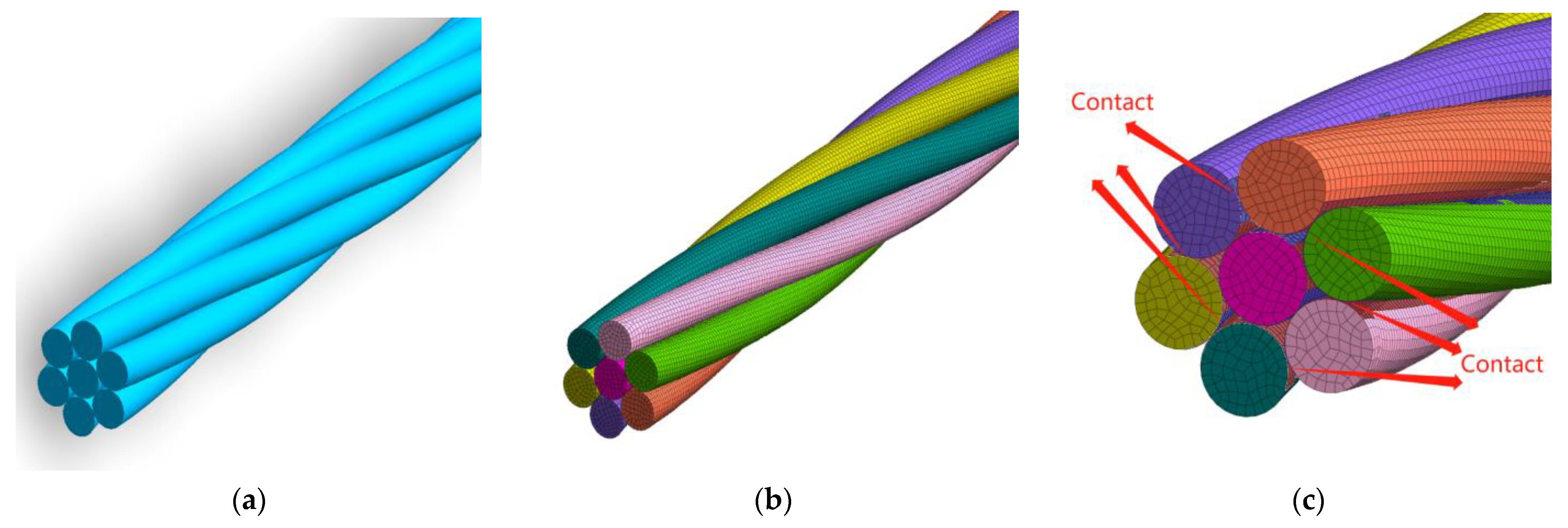


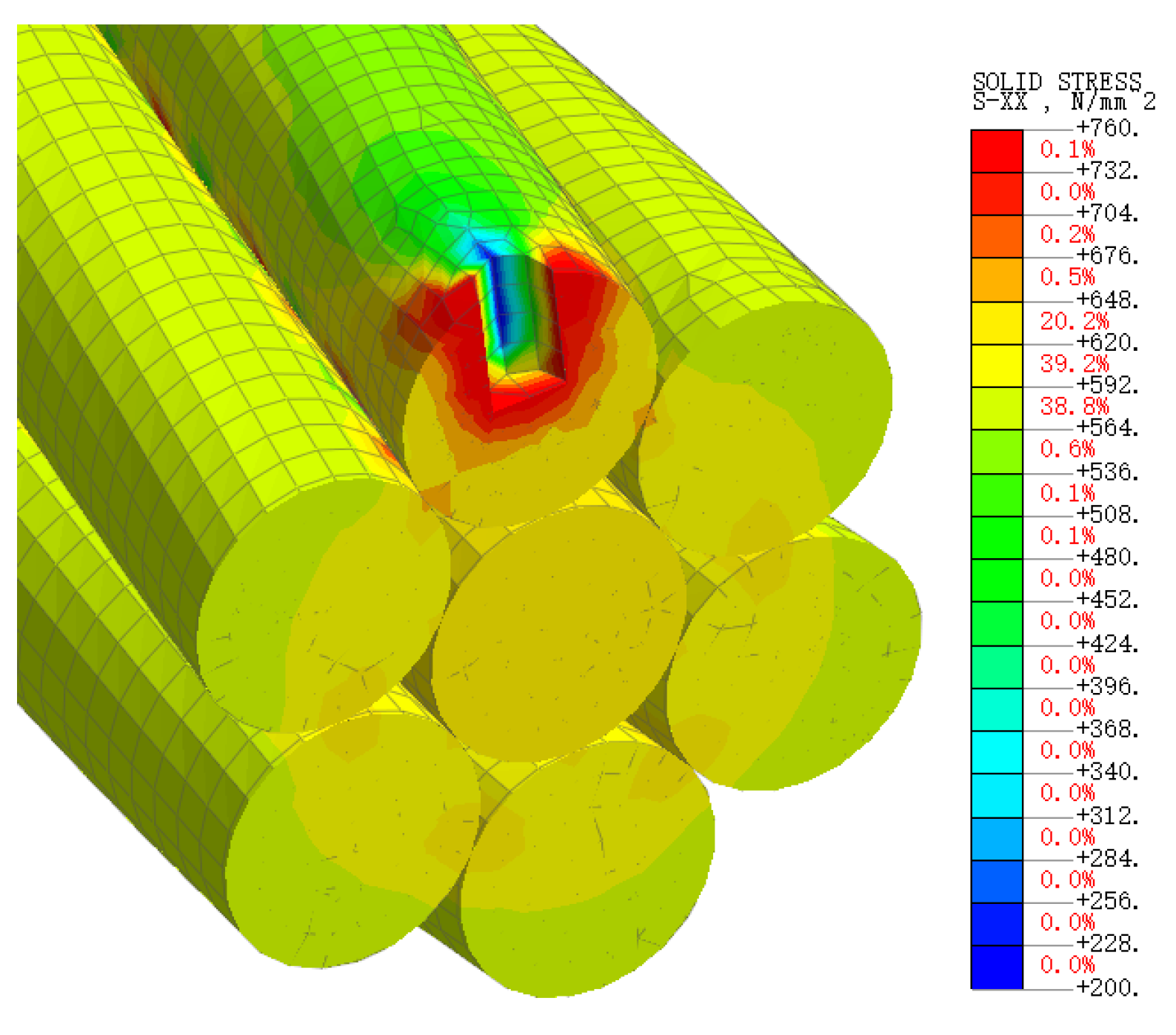
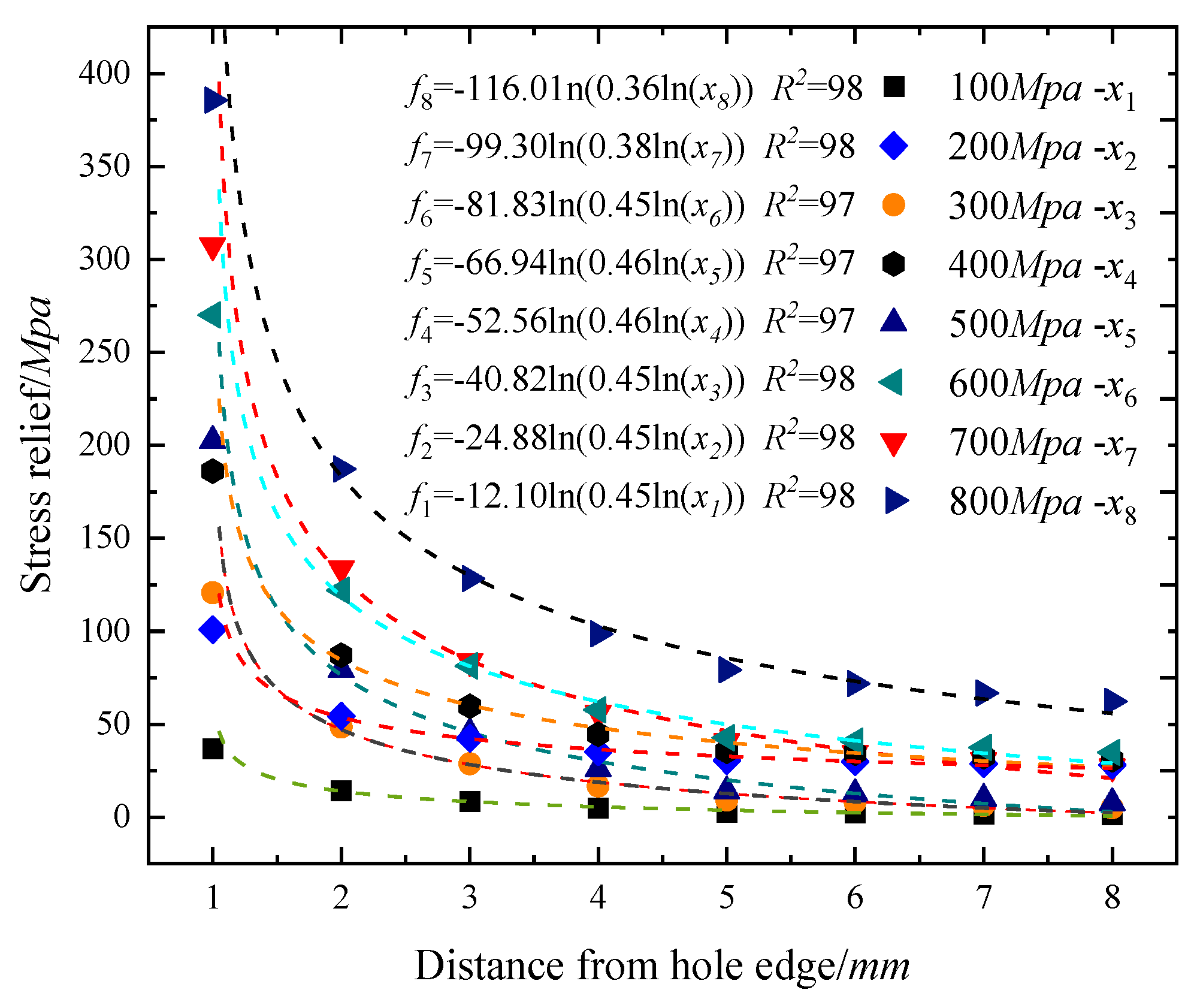



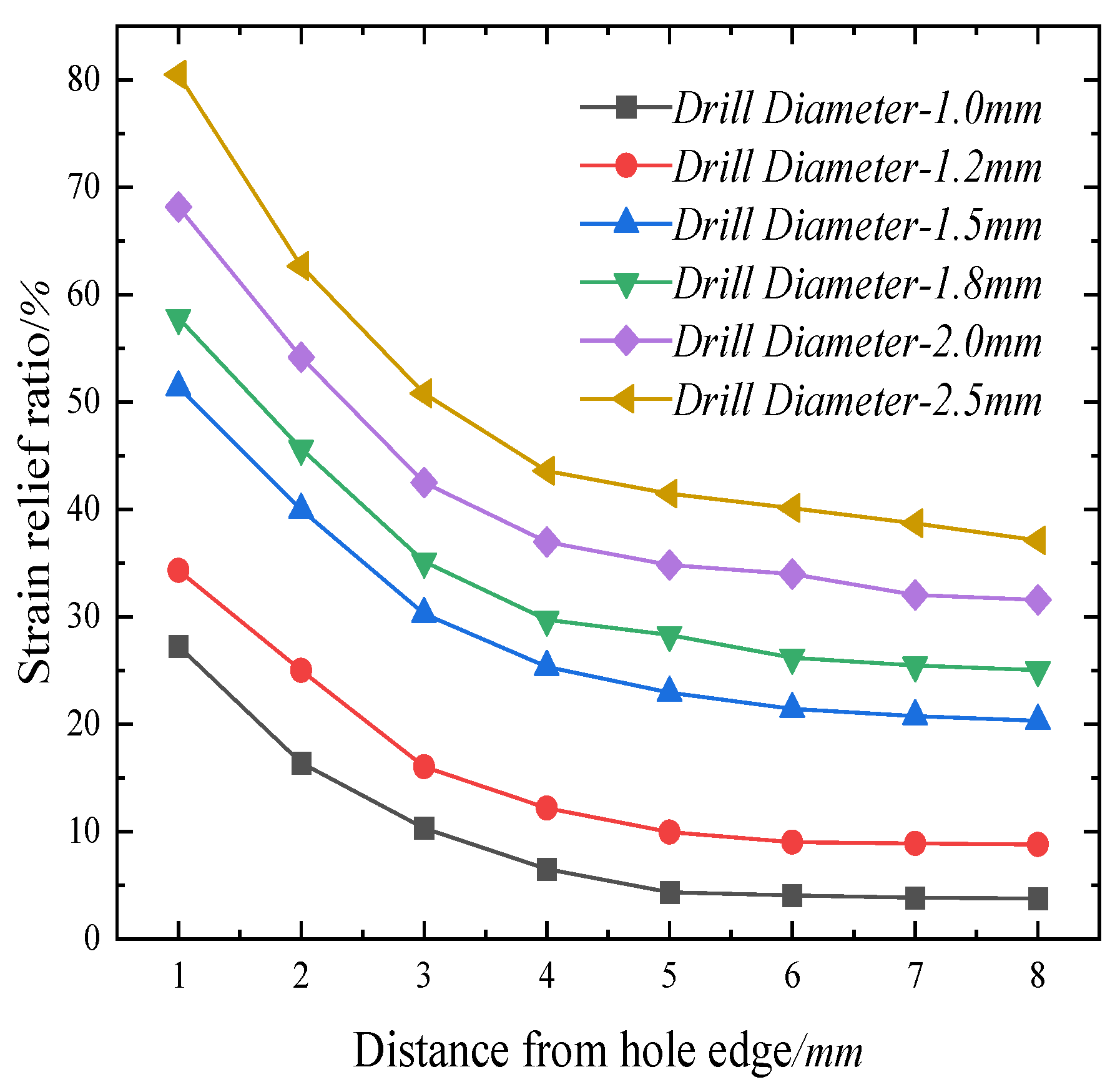

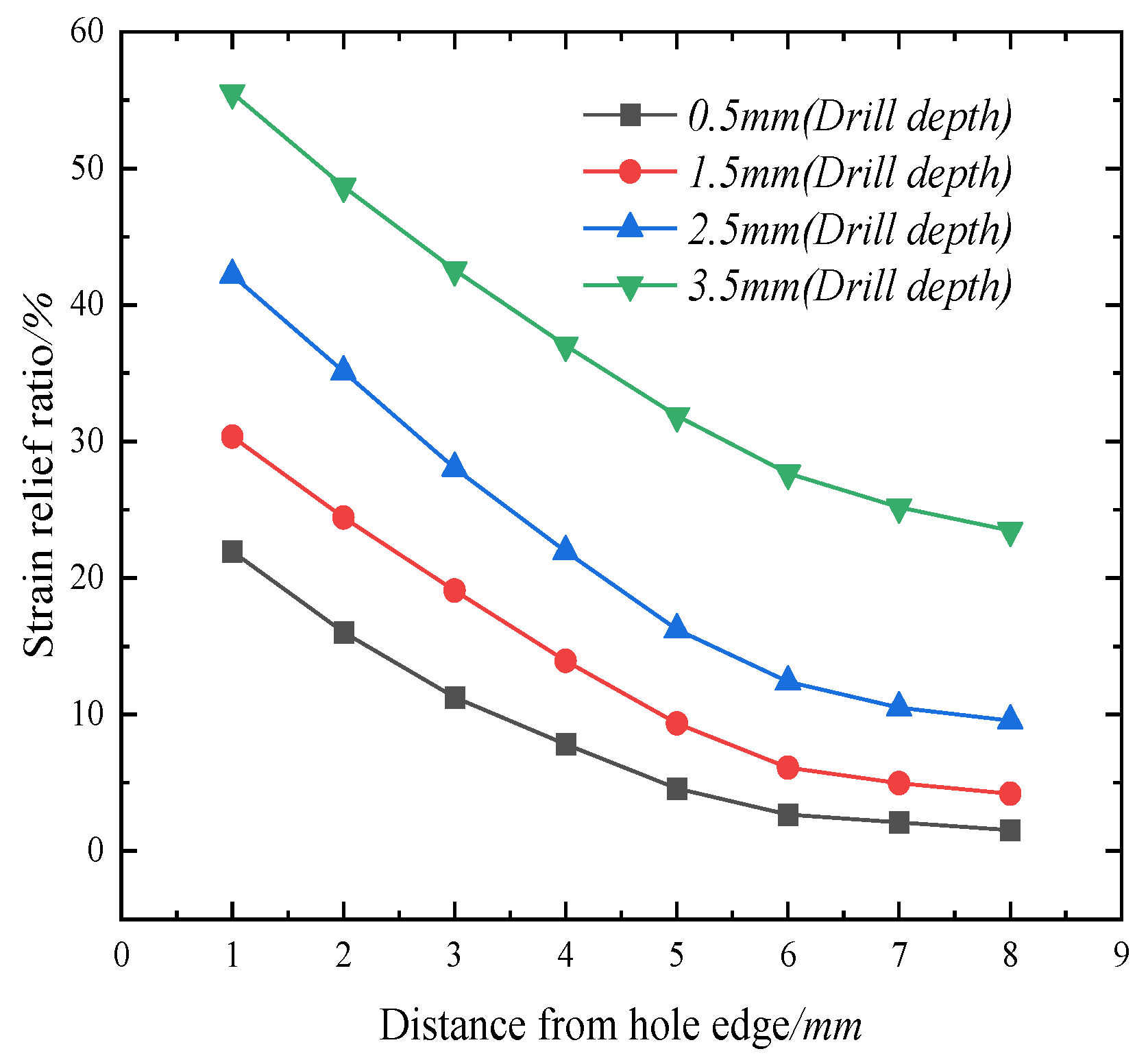
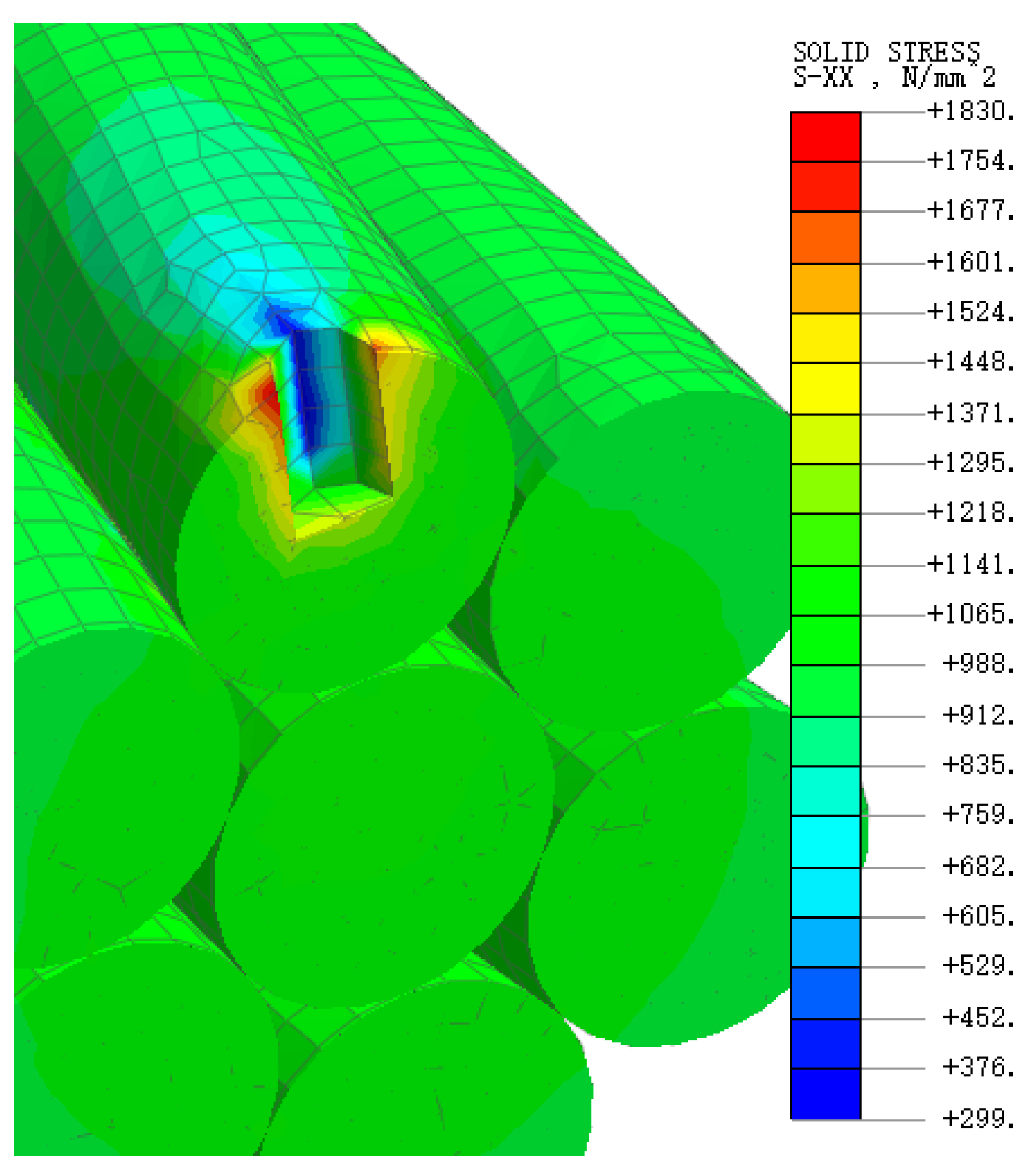

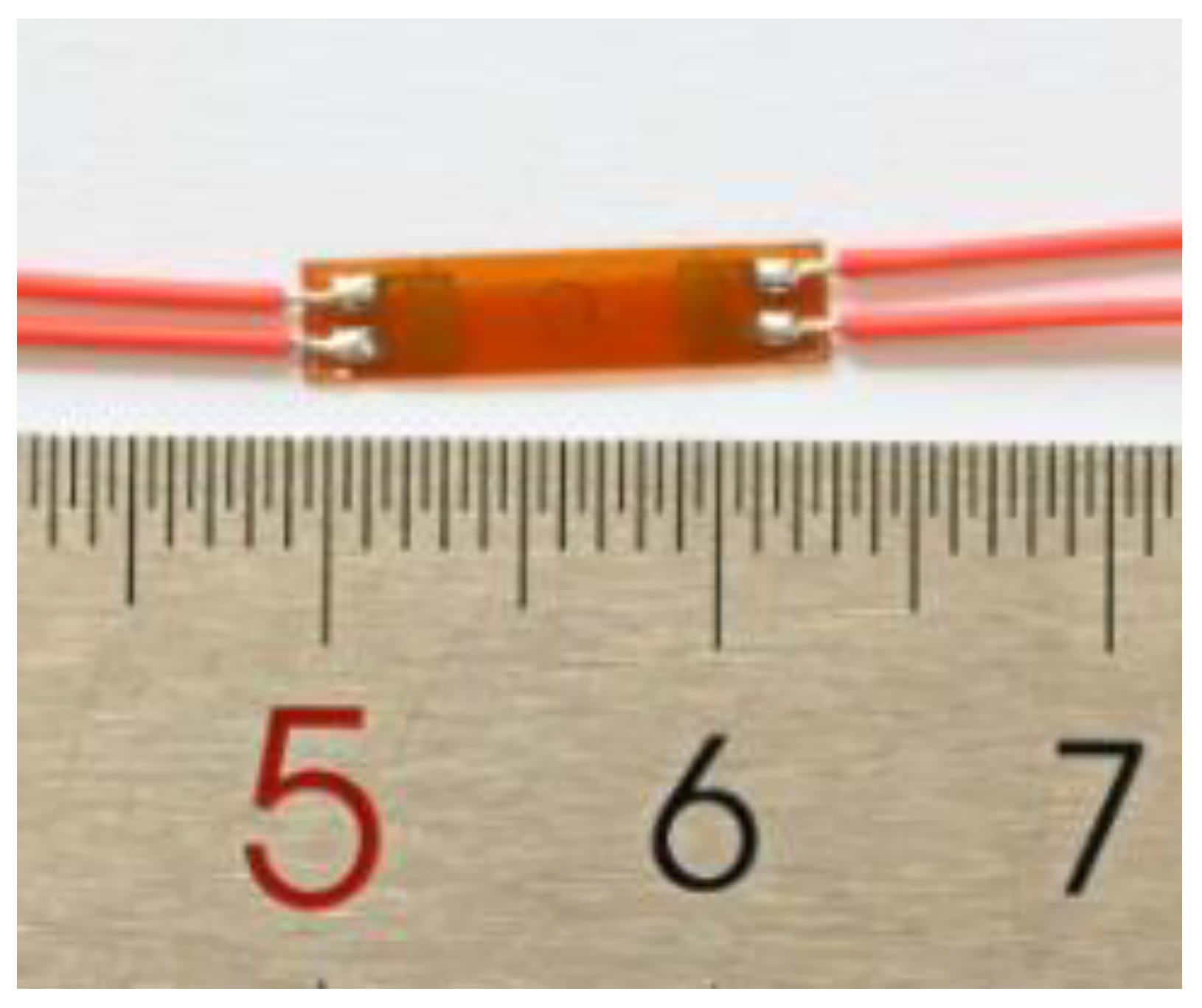



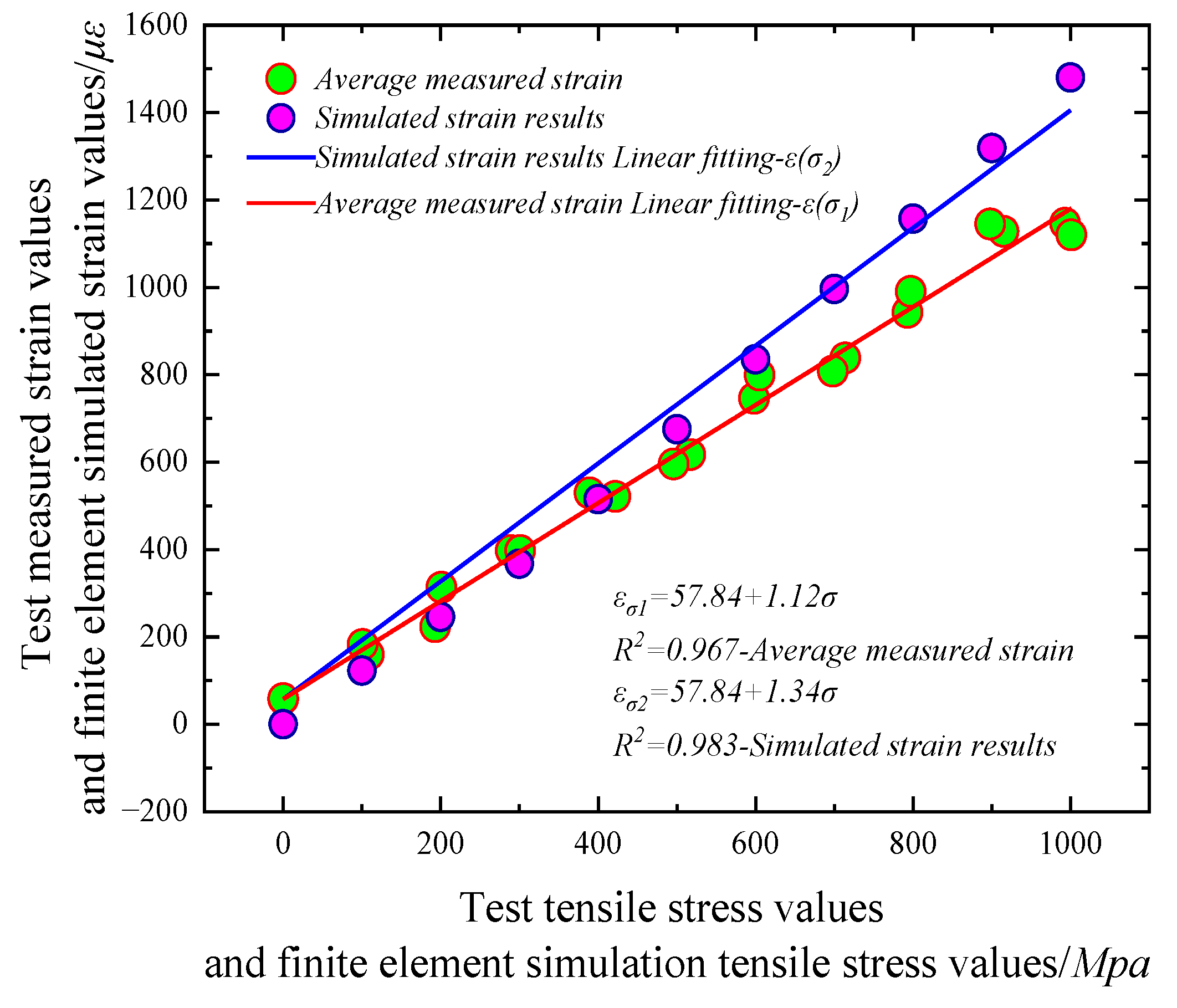
| Structure | Helix Angle/° | Spacing/ mm | Nominal Diameter/ mm | Densities/ g·cm−3 | Strength Class/Mpa | Yield Strength σc/Mpa | Young’s Modulus E/Gpa | Poisson’s Ratio | Mesh Size/mm | Number of Units |
|---|---|---|---|---|---|---|---|---|---|---|
| 1 × 7 | 8.48 | 225 | 15.20 | 7.85 | 1860 | 1581 | 195 | 0.269 | 0.5 | 463,880 |
| Applied Tension Stress/Mpa | Calculations in This Paper | Feyrer [26] Eq. | Relative Error/% | |||
|---|---|---|---|---|---|---|
| Average Stress in Stranded Wire/Mpa | Average Stress on Outer Wire of Steel Strand/Mpa | Average Stress in Stranded Wire/Mpa | Average Stress on Outer Wire of Steel Strand/Mpa | Relative Error of Medium Wire Strand | Relative Error of Outer Wire Strand | |
| 100 | 104.3 | 98.9 | 104.1 | 99.3 | 0.2 | −0.4 |
| 200 | 208.6 | 197.8 | 206.6 | 198.9 | 1.0 | −0.5 |
| 300 | 313.4 | 296.8 | 312.1 | 295.1 | 0.4 | 0.6 |
| 400 | 419.9 | 395.4 | 413.0 | 397.8 | 1.7 | −0.6 |
| 500 | 526.6 | 493.7 | 515.6 | 489.6 | 2.1 | 0.8 |
| 600 | 633.4 | 592.0 | 619.8 | 596.7 | 2.2 | −0.8 |
| Structure | Lose One’s Bearings | Weights/kg | Nominal Diameter/mm | Strength Class/Mpa | Relaxation Level | Measured Cross-Sectional Area/mm2 | Tensile Strength/Mpa |
|---|---|---|---|---|---|---|---|
| 1 × 7 | Left | 1078 | 15.20 | 1860 | Ⅱ | 141 ± 1 | ≥1907 |
| Test Condition | Tensile/kN | Tensile Stress/Mpa | 1# Measuring Point/µε | 2# Measuring Point/µε | 3# Measuring Point/µε | Average Strain at 1#~3# Measurement Points/µε |
|---|---|---|---|---|---|---|
| 1 | 0.0 | 0 | 52.1 | 58.3 | 62.5 | 57.6 |
| 0.0 | 0 | 68.6 | 50.1 | 57.6 | 58.8 | |
| 2 | 15.4 | 109 | 112.2 | 223.3 | 143.8 | 159.8 |
| 14.3 | 101 | 127.3 | 179.2 | 240.5 | 182.4 | |
| 3 | 27.2 | 193 | 251.2 | 195.5 | / | 223.4 |
| 28.4 | 201 | 331 | / | 296 | 313.5 | |
| 4 | 40.8 | 289 | 477.2 | 382.5 | 333.3 | 397.7 |
| 42.5 | 301 | 405.8 | / | 389.7 | 397.8 | |
| 5 | 54.9 | 389 | / | 504.7 | 554.1 | 529.4 |
| 59.6 | 422 | 579.1 | 481.5 | 503.7 | 521.4 | |
| 6 | 73.0 | 517 | 646.2 | / | 587.9 | 617.1 |
| 70.0 | 496 | 618.3 | 541.7 | 627.1 | 595.7 | |
| 7 | 84.4 | 598 | 750.1 | 741.8 | / | 745.9 |
| 85.4 | 605 | 722.2 | / | 876.1 | 799.1 | |
| 8 | 100.8 | 714 | 748.1 | 871.3 | 895.3 | 838.2 |
| 98.5 | 698 | 810.5 | 741.7 | 872.1 | 808.1 | |
| 9 | 111.9 | 793 | 895.3 | 1022.4 | 910.9 | 942.9 |
| 112.5 | 797 | 991.9 | 929.3 | 1050.6 | 990.6 | |
| 10 | 129.1 | 915 | 1008.7 | 1102.1 | 1274.1 | 1128.3 |
| 126.7 | 898 | 1263.1 | 1044.9 | 1126.7 | 1144.9 | |
| 11 | 140.1 | 993 | 1253.2 | 981.9 | 1204.5 | 1146.5 |
| 141.3 | 1001 | / | 1204.7 | 1035.7 | 1120.2 |
Disclaimer/Publisher’s Note: The statements, opinions and data contained in all publications are solely those of the individual author(s) and contributor(s) and not of MDPI and/or the editor(s). MDPI and/or the editor(s) disclaim responsibility for any injury to people or property resulting from any ideas, methods, instructions or products referred to in the content. |
© 2023 by the authors. Licensee MDPI, Basel, Switzerland. This article is an open access article distributed under the terms and conditions of the Creative Commons Attribution (CC BY) license (https://creativecommons.org/licenses/by/4.0/).
Share and Cite
Wu, W.; Chen, S.; Dong, C.; Peng, W.; Yun, J.; Nie, L. Numerical Simulation and Experimental Study on Detecting Effective Prestress of 1860-Grade Strands Based on the Drilling Method. Coatings 2023, 13, 1869. https://doi.org/10.3390/coatings13111869
Wu W, Chen S, Dong C, Peng W, Yun J, Nie L. Numerical Simulation and Experimental Study on Detecting Effective Prestress of 1860-Grade Strands Based on the Drilling Method. Coatings. 2023; 13(11):1869. https://doi.org/10.3390/coatings13111869
Chicago/Turabian StyleWu, Wenxiang, Shunchao Chen, Chunyan Dong, Wenbai Peng, Jianzhou Yun, and Liangpeng Nie. 2023. "Numerical Simulation and Experimental Study on Detecting Effective Prestress of 1860-Grade Strands Based on the Drilling Method" Coatings 13, no. 11: 1869. https://doi.org/10.3390/coatings13111869




